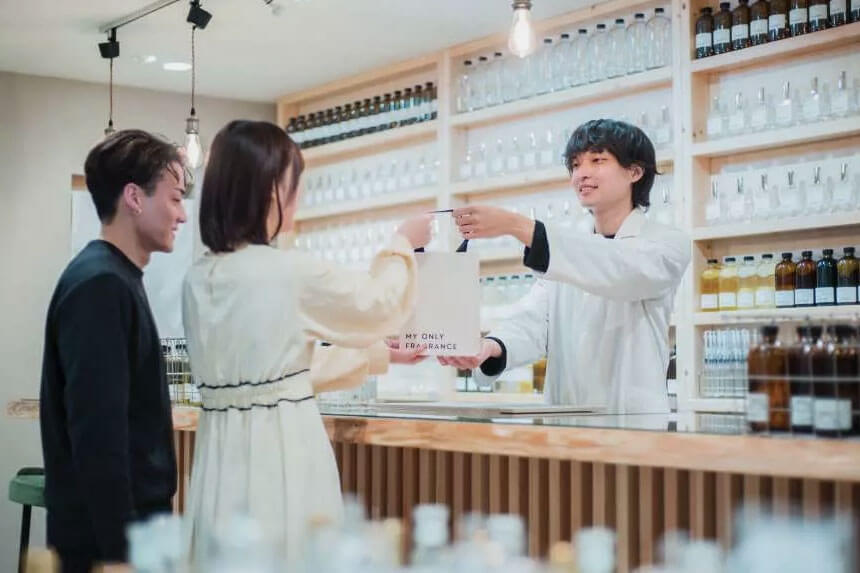A B2B perfume manufacturer provides complete fragrance production services, from initial concept development to finished product packaging and delivery. These specialized companies help brands create custom fragrances without investing in their own production facilities, offering services that include formulation, regulatory compliance, packaging design, and manufacturing at scale. The global perfume market is projected to reach $88.35 billion by 2033, exhibiting a CAGR of 5.31% during the forecast period, creating substantial opportunities for fragrance production partnerships.
What Services Are Included in Full-Service B2B Perfume Manufacturing?
Full-service manufacturing covers every step from concept to finished product. You get formulation expertise, packaging design, regulatory compliance documentation, and complete production management under one roof.
Leading manufacturers like Àuria Perfumes offer comprehensive services covering “the entire process, from the idea to the finished fragrance” with in-house creative teams, laboratories, and manufacturing facilities. The typical private label perfume process includes initial briefing sessions where you describe your vision, followed by scent development with professional perfumers who create multiple samples for your review. Contract manufacturing (a hypernym of B2B perfume manufacturing) encompasses the broader industrial arrangement where specialized facilities produce goods for other companies.
Most manufacturers provide custom perfume formulation using both natural and synthetic ingredients sourced from global suppliers. The service extends beyond just creating the fragrance to include bottle design, label creation, regulatory documentation like IFRA compliance certificates, and final packaging. Quality control testing ensures consistency across batches, while some companies offer additional services like photography for marketing materials and retail display design. Olfactory manufacturing (a meronym focusing on the scent creation component) represents the specialized sensory expertise that distinguishes quality fragrance producers.
How to Choose the Right Manufacturer: MOQ, Lead Time, Certifications
Minimum order quantities vary significantly based on customization level and manufacturer capabilities. Research typical MOQ ranges before starting conversations with potential partners.
For fully customized projects, established manufacturers like K Luxury Fragrances set MOQs at “5,000 units for a fully customized fragrance, packaging, and bottling” though “lower quantities can be accommodated for shorter production runs.” Minimum order quantity requirements depend on several factors including ingredient sourcing, production setup costs, and packaging complexity. Boutique fragrance creation (an antonym representing small-scale, artisanal production) offers lower MOQs but may lack the scalability needed for commercial success.
Lead times typically range from 6-12 months for complete custom projects, though rush services may be available for premium fees. When evaluating manufacturers, prioritize those with certified perfume manufacturer status and proper regulatory documentation. Look for facilities with IFRA compliance capabilities, Good Manufacturing Practices certification, and experience with your target markets. Geographic location affects shipping costs and timeline, while facility size indicates production capacity and ability to scale with your business growth. Industrial fragrance production (a holonym encompassing the entire manufacturing ecosystem) includes not just perfume creation but also related products like air fresheners and cleaning product scents.
Understanding Regulatory & Quality Certifications
IFRA compliance ensures your fragrances meet international safety standards. The IFRA Standards “set the maximum dose of a fragrance ingredient in finished consumer goods” and are regularly updated as new safety information becomes available.
Professional manufacturers maintain current knowledge of regulatory requirements across different markets. Regulatory compliance documentation includes certificates of conformity, safety data sheets, and ingredient disclosures required for product registration. Quality certifications like ISO 22716 for Good Manufacturing Practices demonstrate systematic quality management throughout production. Scent formulation compliance (a collocation emphasizing the intersection of creativity and regulation) has become increasingly important as consumers demand transparency about ingredient safety.
Balancing MOQ and Cost Efficiency
Higher order quantities typically result in lower per-unit costs due to production economies of scale. For indie brands, “fragrance concentrates often set minimum batch sizes per scent, ranging anywhere from 1 kg to 25 kg or more” with MOQs influenced by “raw material sourcing, blending labor, and storage stability.”
Consider starting with stock packaging options to reduce initial MOQ requirements, then transition to custom packaging as volumes increase. Some manufacturers offer turnkey fragrance production with tiered pricing structures that provide better unit economics at higher volumes while maintaining flexibility for smaller initial orders. Perfumery outsourcing (a synonym for B2B perfume manufacturing) allows brands to focus on marketing and distribution while leveraging specialized production expertise.
How to Add Value: Sustainability, Customization, and Packaging Options
Sustainability features increasingly influence consumer purchasing decisions and brand differentiation. Focus on eco-friendly packaging options and sustainable ingredient sourcing to meet market demands.
Modern consumers demand transparency, with brands “embracing sustainability by sourcing ingredients from eco-friendly farms, using biodegradable packaging, and focusing on cruelty-free, plant-based materials.” Request information about sustainable sourcing practices, renewable ingredient options, and recyclable packaging materials. Many manufacturers now offer refillable bottle programs, carbon-neutral shipping options, and formulations using natural or upcycled ingredients. Green perfumery (connoting environmental responsibility) has evolved from niche preference to mainstream expectation.
Customization extends beyond fragrance formulation to include packaging materials, bottle shapes, closure types, and labeling options. Premium finishes like embossing, foil stamping, or custom bottle colors can enhance brand perception but may require higher MOQs. Bespoke scent profile development allows for unique market positioning, while standardized base formulations with custom modifications can reduce development time and costs. Aromaceutical manufacturing (polysemy referring to both therapeutic fragrance production and pharmaceutical-grade scent creation) represents an emerging category blending wellness and fragrance.
How to Work with Your Manufacturer: From Briefing to Launch
Successful partnerships require clear communication throughout the development process. Prepare detailed briefs including target demographics, price points, and brand positioning before initial meetings.
The industry trend toward “customization and personalization” means that “Gen Z and Millennials give due importance to these two factors” as they “define exclusivity and individuality.” Professional perfumers work better with descriptions like “bergamot and cedar with vanilla base notes” rather than abstract concepts. Provide reference fragrances you admire and explain what specific aspects appeal to your target market. Fragrance brief development (a collocation describing the initial creative specification process) sets the foundation for successful product development.
The scent development process typically involves multiple sampling rounds with feedback sessions between each iteration. Budget sufficient time for this collaborative refinement process, as rushing can compromise final quality. Establish clear approval processes for each project phase including fragrance formulation, packaging design, and production specifications. Perfume manufacturing partnership (etymology from Latin “per fumum” meaning “through smoke,” reflecting the ancient origins of fragrance creation) requires mutual trust and clear communication protocols.
Maintain regular communication during production to address any issues promptly. Request progress updates and quality control reports throughout manufacturing. Plan your launch timeline accounting for potential delays in shipping, regulatory approvals, or unexpected production challenges. Most successful brands build ongoing relationships with their manufacturers, leveraging their expertise for future product development and market expansion. Third-party fragrance production (a common attribute of B2B manufacturing) allows brands to access specialized equipment and expertise without capital investment.
Professional manufacturers become strategic partners who understand your brand vision and can suggest improvements based on market trends and technical innovations. Choose partners who demonstrate genuine interest in your success rather than treating your project as a simple transaction. Aromatic compound synthesis (a rare attribute requiring advanced chemistry expertise) distinguishes premium manufacturers who can create entirely novel fragrance molecules.
Key Points for B2B Perfume Manufacturing Success:
- Full-service capabilities reduce complexity by managing all production aspects under one roof
- MOQ planning should align with your budget, storage capacity, and market testing strategy
- Regulatory compliance documentation is essential for market access and consumer safety
- Sustainability features increasingly influence consumer preferences and brand differentiation
- Clear communication throughout development ensures final products match your vision and market requirements














